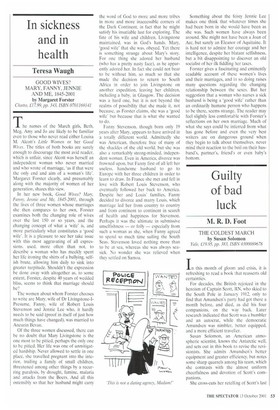Guilty of bad luck
M. R. D. Foot
THE COLDEST MARCH by Susan Solomon
Yale, £19.95, pp. 383, ISBN 0300089678
In this month of gloom and crisis, it is refreshing to read a book that reasserts old certainties.
For decades, the British rejoiced in the heroism of Captain Scott, RN, who skied to the South Pole in January 1912, only to find that Amundsen's party had got there a month before, and died, as did his four companions, on the way back, Later research indicated that Scott was a bumbler and an autocrat, while the democratic Amundsen was nimbler, better equipped, and a more efficient traveller.
Susan Solomon, an American atmospheric scientist, knows the Antarctic well, and sets out in this book to revise the revisionists. She admits Amundsen's better equipment and greater efficiency, but notes some sharp quarrels among his team, which she contrasts with the almost uniform cheerfulness and devotion of Scott's companions.
She cross-cuts her retelling of Scott's last expedition with brief summaries of what life is like at the South Pole today. The Stars and Stripes fly there, to mark a small, permanently manned American scientific base and airstrip, to which a few intrepid tourists manage to penetrate as well. Even the tourists can get frostbitten fast enough; though they may not echo Scott's cry, 'Great God! This is an awful place', they get intimations of how fierce the surroundings can be.
They do not have to cross crevasses in a glacier, as Scott's parties did; one seaman put it that he and two friends went along the crossbar to the H of Hell' as they manhandled a 400-pound sledge across a snow bridge, narrower than the sled, over an apparently bottomless chasm of ice. Nor do they have to live on pemmican and tea; the modern polar hutments have a wellstocked bar and a cafeteria.
Over and over again, Solomon picks on the legends that have accumulated round Scott to his disadvantage, and disproves them. She shows that he took reasonable precautions, and was keenly interested in science; he simply had bad luck. His start for the Pole was delayed by hitches, none of them his own fault; by the practical impossibility of getting a motor sledge (on tracks: forerunner of the tank) to work in temperatures that were too cold for its engine; by difficulties with the ponies, ill chosen for him at a Manchurian bazaar; even by an unexpectedly thick belt of pack ice, which held up Terra Nova during the approach voyage.
Worst of all, his late start landed him with the need to make his return journey across the great ice desert as the winter cold closed in on him; and in the closing stages, he had worse weather — by about ten degrees — than is at all normal even for that time of year. The essential figures were published as long ago as 1923, in Calcutta, by Scott's chief scientist 'Sunny Jim' Simpson; unnoticed of course by Scott's detractors. Solomon is able to deploy them alongside many years of temperature records maintained by later weather bases, spaced out across the continent. Scott's trouble was that at these extra low temperatures — some 60, instead of 50, degrees Fahrenheit of frost — skiing was difficult and dragging a sled all but impossible: whenever it had snowed, the ice surface became rough as sandpaper.
She adds an original final twist. Weather statistics do not bear out Scott's claim of a nine-day blizzard, in which his party were stuck in their tent a dozen miles from their next depot of food. She maintains that a blizzard did stop them for a few days, but that Scott had feet so badly frostbitten that he could march no farther, and his companions, Wilson and Bowers, chose to die with him rather than to abandon him for their own safety. All their bodies were found, in their tent under six feet of snow, next spring. We can truly believe they were heroes.



























































































 Previous page
Previous page